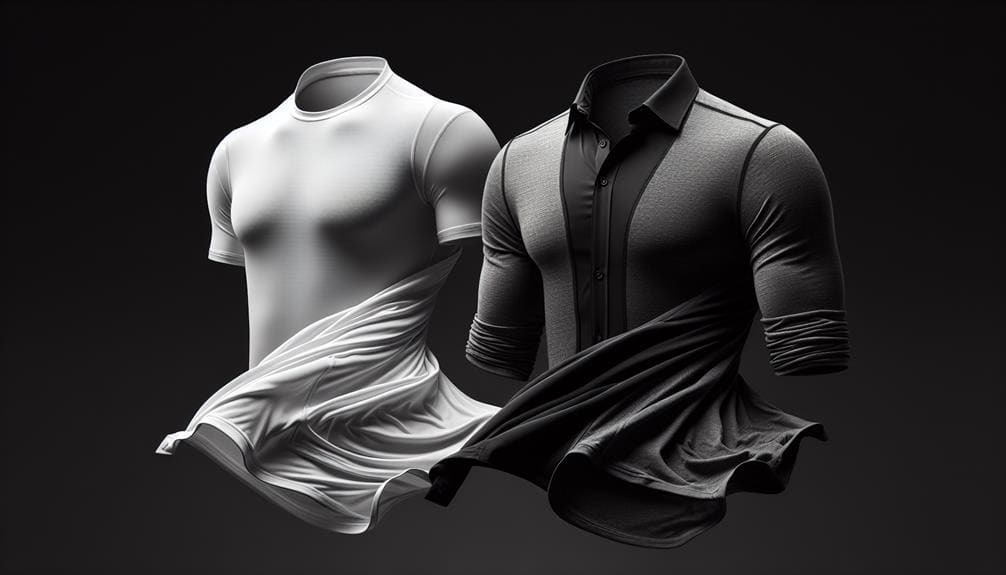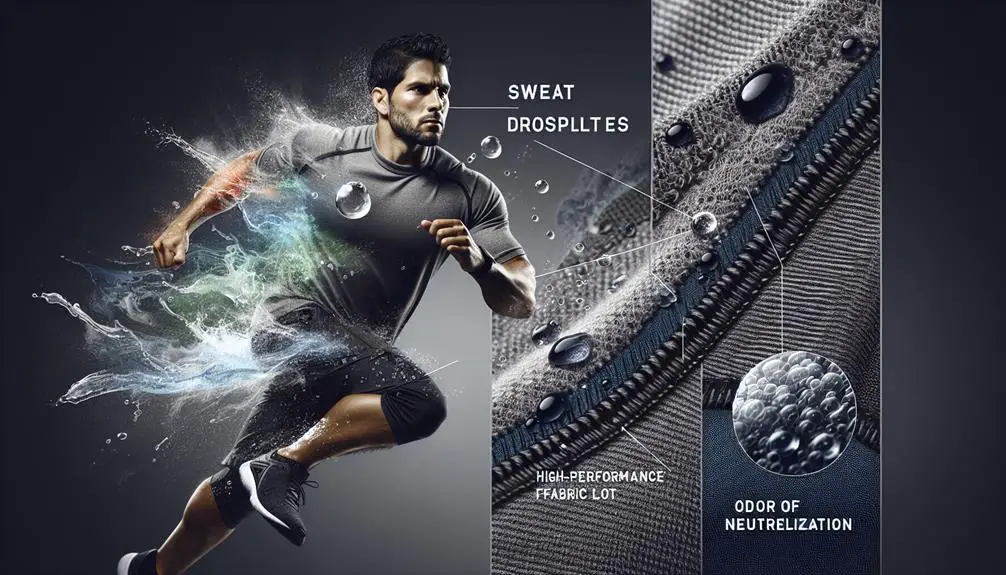To keep eco-friendly athletic wear odor-resistant and moisture-wicking, natural fabrics like bamboo and hemp are key. These materials combat odor by fighting bacteria growth, thanks to bamboo's antibacterial properties and hemp's antimicrobial bio-agents. When it comes to moisture-wicking, fabrics like polyester and polypropylene excel, managing sweat through capillary action and promoting evaporation. The sustainable nature of bamboo and hemp textiles makes them an eco-friendly choice. If you want to understand how these fabrics work in more detail, explore the science behind odor control and moisture management in athletic wear.
Key Points
- Bamboo and hemp textiles have natural antimicrobial properties.
- Moisture-wicking fabrics use capillary action for sweat management.
- Sustainable materials like bamboo and hemp combat odor-causing bacteria.
- Eco-friendly dyeing methods reduce water consumption in production.
- Recycled materials and ethical labor practices promote sustainable athletic wear.
Natural Fabrics Combat Odor
Natural fabrics like bamboo and merino wool actively fight against odor-causing bacteria, making them an ideal choice for athletes seeking long-lasting freshness during workouts. Bamboo fibers, in particular, possess inherent antibacterial and antifungal properties due to a bio-agent called 'bamboo kun.' This substance helps bamboo plants resist pests and fungi in nature, and when used in textiles, it carries over these protective qualities.
Hemp textiles also exhibit similar odor-resistant properties, making them a sustainable alternative for eco-conscious athletes. The porous nature of bamboo fibers allows for better moisture absorption and ventilation, reducing the buildup of sweat that can lead to bacterial growth and unpleasant odors.
Additionally, the structure of hemp fibers naturally prevents the growth and proliferation of odor-causing bacteria, ensuring that your athletic wear stays fresh even after intense workouts. By choosing garments made from bamboo fibers or hemp textiles, you not only prioritize your comfort and performance but also contribute to sustainable and environmentally friendly practices in the textile industry.
Anti-Microbial Properties Explained
Bamboo and hemp textiles possess inherent properties that actively combat the growth of odor-causing bacteria, ensuring long-lasting freshness in your athletic wear. These natural fibers exhibit remarkable antimicrobial properties that contribute to their effectiveness in maintaining odor control. The key to this microbial defense lies in the composition of bamboo and hemp fibers, which naturally contain antimicrobial bio-agents that hinder the proliferation of odor-causing bacteria.
When moisture from sweat is absorbed into these fabrics during physical activity, the antimicrobial properties of bamboo and hemp work to inhibit the growth of bacteria that typically thrive in damp environments. By limiting bacterial growth, these natural fibers prevent the accumulation of odors in your athletic wear, allowing you to stay fresh and comfortable throughout your workout.
The sustainable nature of bamboo and hemp textiles makes them an eco-friendly choice for individuals seeking high-performance athletic wear with long-lasting odor-resistance capabilities.
Moisture-Wicking Technology Breakdown
Exploring the intricate mechanisms of moisture-wicking technology reveals the sophisticated processes that enable athletic wear to efficiently manage sweat during physical activity. Fabric technology plays a vital role in this functionality. Moisture-wicking fabrics are typically made of synthetic materials like polyester or polypropylene. These fabrics are engineered to have capillary action, which allows them to pull moisture away from the skin and spread it across a larger surface area, promoting faster evaporation. This process helps in regulating body temperature and keeping you dry during intense workouts.
The key to effective sweat management lies in the construction of the fabric. Microscopic spaces between the fibers of moisture-wicking fabrics create pathways for moisture to move away from the body. By efficiently transferring sweat to the outer surface of the garment, these fabrics accelerate the evaporation process, preventing the accumulation of moisture that can lead to discomfort and chafing. Understanding the science behind moisture-wicking technology can empower you to make informed choices when selecting athletic wear for ideal performance and comfort.
Sustainable Materials for Odor Control
Understanding how sustainable materials contribute to odor control in athletic wear is essential for maximizing comfort and performance during physical activities. When it comes to odor-resistant athletic wear, the materials used play a vital role. Two sustainable materials that excel in odor control are bamboo fibers and silver nanoparticles.
- Bamboo Fibers:
- Bamboo fibers are naturally antimicrobial, making them effective in preventing the growth of odor-causing bacteria.
- The porous structure of bamboo fibers allows for better moisture absorption, reducing the conditions where bacteria thrive.
- Bamboo is also known for its breathability, ensuring sweat and moisture are wicked away from the body, further preventing odors.
- Silver Nanoparticles:
- Silver nanoparticles have antimicrobial properties, inhibiting the growth of odor-causing bacteria.
- The tiny size of silver nanoparticles allows for better penetration into fabrics, ensuring long-lasting odor control.
- Silver nanoparticles are durable and can withstand multiple washes without losing their effectiveness in odor control.
Eco-Friendly Practices in Athletic Wear
Implementing eco-friendly practices in the production of athletic wear is essential for reducing environmental impact and promoting sustainability in the fashion industry. To achieve this, brands are turning to eco-friendly dyeing methods and sustainable production processes.
Eco-friendly dyeing methods involve using natural or low-impact dyes that minimize the use of harmful chemicals and reduce water consumption during the dyeing process. These methods guarantee that the wastewater from production is less harmful to the environment.
Additionally, sustainable production processes focus on reducing waste, energy consumption, and overall carbon footprint. This includes utilizing recycled materials, implementing efficient manufacturing techniques, and promoting ethical labor practices.
Frequently Asked Questions
What Are Some Common Misconceptions About Eco-Friendly Athletic Wear and Its Effectiveness in Combating Odor and Moisture?
Common myths surround eco-friendly athletic wear's performance claims in combating odor and moisture. Misunderstood benefits include its durability and sustainability impact. Understanding these factors can enhance your appreciation for the functionality of eco-friendly sportswear.
How Do Eco-Friendly Athletic Wear Brands Ensure That Their Products Are Both Odor-Resistant and Moisture-Wicking Without Compromising on Performance?
To guarantee eco-friendly athletic wear is odor-resistant and moisture-wicking, sustainable materials and innovative technologies are used. Brands conduct performance testing and gather consumer feedback to refine products. This meticulous process guarantees high-quality, effective sportswear.
Are There Any Specific Certifications or Standards That Consumers Should Look for When Shopping for Eco-Friendly Athletic Wear With Odor-Resistant and Moisture-Wicking Properties?
When shopping for eco-friendly athletic wear with odor-resistant and moisture-wicking properties, you should look for specific certification standards. Brands that prioritize transparency in their manufacturing processes often display these certifications, providing you assurance of product quality.
Can Natural Fabrics Alone Provide Sufficient Odor Control and Moisture-Wicking Capabilities in Athletic Wear, or Are Additional Treatments or Technologies Necessary?
Natural fibers alone may not always suffice for top-tier performance in athletic wear. Incorporating advanced technology enhances sustainability and boosts performance. Balancing natural properties with innovative treatments is key to achieving peak odor control and moisture-wicking capabilities.
How Do Eco-Friendly Athletic Wear Brands Address Concerns About Durability and Longevity While Maintaining Odor-Resistant and Moisture-Wicking Properties in Their Products?
To guarantee durability and performance benefits in eco-friendly athletic wear, brands emphasize fabric construction and sustainability practices. Incorporating innovative technologies and materials, these brands enhance longevity while maintaining top-tier odor resistance and moisture-wicking capabilities.




